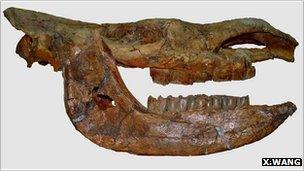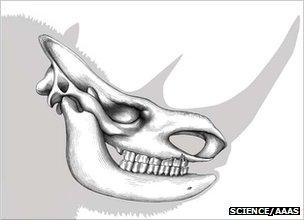'Oldest' woolly rhino discovered
- Published

The discovery team says it might have used its horn as a paddle to sweep snow from vegetation
A woolly rhino fossil dug up on the Tibetan Plateau is believed to be the oldest specimen of its kind yet found.
The creature lived some 3.6 million years ago - long before similar beasts roamed northern Asia and Europe in the ice ages that gripped those regions.
The discovery team says the existence of this ancient rhino supports the idea that the frosty Tibetan foothills of the Himalayas were the evolutionary cradle for these later animals.
The report, external appears in Science journal.
"It is the oldest specimen discovered so far," said Xiaoming Wang from the Natural History Museum of Los Angeles County, US.
"It is at least a million years older, or more, than any other woolly rhinos we have known.
"It's quite well preserved - just a little crushed, so not quite in the original shape; but the complete skull and lower jaw are preserved," he told BBC News.
The rhino was found in Tibet's Zanda Basin. The area is rich in fossil beds, and this specimen was unearthed along with examples of extinct horse, antelope, snow leopard, badger and many other kinds of mammals.
It has been put in a new species classification - Coelodonta thibetana.
Dr Wang and colleagues say it displays some very primitive features compared with its counterparts that lived through the later great glaciations of the Pleistocene Epoch.

The Tibetan woolly rhino fossil is in generally good condition, if a little misshapen
Judging from marks on the skull, the creature's horn, which has not survived, would likely have been quite flat in construction and leaning forward.
This might have allowed the animal more easily to sweep snow out of the way to get at vegetation, a useful behaviour for survival in the harsh Tibetan climate, the team says.
"We think it would have used its horn like a paddle to sweep the snow away," Dr Wang explained.
Although the extinction of the Pleistocene beasts, such as woolly mammoths and rhinos, great sloths and sabre-tooth cats, has been intensively studied in recent years, much less is known about where these giants came from and how they acquired their adaptations for living in a cold environment.
The argument made in the Science paper is that perhaps they got those adaptations on the Tibetan Plateau.
"When this rhino existed, the global climate was much warmer and the northern continents were free of the massive ice sheets seen in the later ice ages," Dr Wang said.

The horn has not been preserved but its nature has been judged from the skull
"Then, about a million years later, when the ice age did hit the world, these Tibetan woolly rhinos were basically pre-adapted to the ice age environment because they had this ability to sweep snows.
"They just happily came down from the high altitude areas and expanded to the rest of Eurasia."
The Los Angeles-based researcher concedes that many more fossil finds will be required to underpin the Tibetan hypothesis.
Andy Currant, an expert on the Pleistocene (1.8 million to about 11,000 years ago) at London's Natural History Museum, says this is not straightforward in the case of woolly rhinos, and good specimens can sometimes be hard to come by.
"Woolly rhino were preyed on by spotted hyenas and they were eaten pretty thoroughly; the hyenas liked the bones," he told BBC News.

The Zanda Basin is rich in fossils but is largely unexplored by palaeontologists
- Published24 March 2011